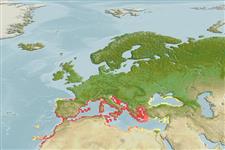Teleostei (teleosts) >
Atheriniformes (Silversides) >
Atherinidae (Silversides) > Atherininae
Etymology: Atherina: Greek, atherina, the Greek name for the eperlane; 1770 (Ref. 45335).
More on author: Linnaeus.
Environment: milieu / climate zone / depth range / distribution range
Ecology
Marine; freshwater; brackish; pelagic-neritic. Subtropical; 45°N - 25°N, 20°W - 45°E
Eastern Atlantic: coasts of Spain and Morocco including Madeira and the Canary Islands. Also in the western Mediterranean, Adriatic Sea and Black Sea.
Size / Weight / Age
Maturity: Lm ? range ? - ? cm
Max length : 20.0 cm TL male/unsexed; (Ref. 5980); common length : 15.0 cm TL male/unsexed; (Ref. 5980)
Total scales in midlateral series 59-65. Anal fin with 10-12 1/2 rays (Ref. 59043).
Littoral, often near shore. Gregarious, sometimes occurs in marine lagoons (France) and estuaries (Portugal). Feed on pelagic copepods and benthic crustaceans (Ref. 5980).
Life cycle and mating behavior
Maturities | Reproduction | Spawnings | Egg(s) | Fecundities | Larvae
Maugé, L.A., 1990. Atherinidae. p. 604-605. In J.C. Quero, J.C. Hureau, C. Karrer, A. Post and L. Saldanha (eds.) Check-list of the fishes of the eastern tropical Atlantic (CLOFETA). JNICT, Lisbon; SEI, Paris; and UNESCO, Paris. Vol. 2. (Ref. 4499)
IUCN Red List Status (Ref. 130435)
Threat to humans
Harmless
Human uses
Fisheries: highly commercial
Tools
Special reports
Download XML
Internet sources
Estimates based on models
Preferred temperature (Ref.
123201): 16.1 - 21.1, mean 19 °C (based on 523 cells).
Phylogenetic diversity index (Ref.
82804): PD
50 = 0.5312 [Uniqueness, from 0.5 = low to 2.0 = high].
Bayesian length-weight: a=0.00550 (0.00429 - 0.00703), b=3.08 (3.01 - 3.15), in cm total length, based on LWR estimates for this species (Ref.
93245).
Trophic level (Ref.
69278): 3.2 ±0.33 se; based on food items.
Resilience (Ref.
120179): Medium, minimum population doubling time 1.4 - 4.4 years (Preliminary K or Fecundity.).
Fishing Vulnerability (Ref.
59153): Low vulnerability (10 of 100).
Nutrients (Ref.
124155): Calcium = 130 [79, 276] mg/100g; Iron = 1.31 [0.75, 2.20] mg/100g; Protein = 20.8 [19.3, 22.2] %; Omega3 = 0.379 [0.190, 0.732] g/100g; Selenium = 11.5 [5.3, 25.4] μg/100g; VitaminA = 24.7 [8.7, 69.4] μg/100g; Zinc = 1.45 [1.02, 2.08] mg/100g (wet weight);
